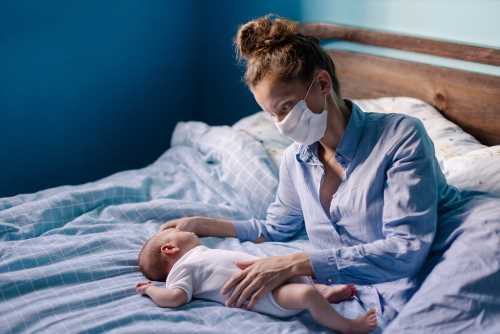SARS-CoV-2 infection among infants born to maternal COVID-19 cases during Omicron variant predominance
In a recent study published in the Pediatrics Journal, researchers assessed the incidence rate of severe acute respiratory syndrome coronavirus 2 (SARS-CoV-2) infections pre- and post-SARS-CoV-2 Omicron variant of concern (VOC) dominance among infants born to SARS-CoV-2-positive mothers.
They also investigated whether the duration of maternal SARS-CoV-2 infection affected neonatal susceptibility.

Study: SARS-CoV-2 During Omicron Variant Predominance Among Infants Born to People With SARS-CoV-2. Image Credit: DaAntipina/Shutterstock.com
Background
The continual evolution of SARS-CoV-2 has led to several VOCs with varying transmissibility, virulence, and immune evasiveness.
Omicron, although highly transmissible, causes less severe infections among the general public. However, a rise in neonatal hospitalizations has been reported, during the Omicron wave, compared to prior VOC waves.
Maternal COVID-19 may result in the transplacental transfer of antibodies against SARS-CoV-2 to neonates; however, the passively acquired humoral protection rapidly wanes within six months.
Moreover, COVID-19 vaccines have not been authorized for infants aged below 6.0 months, and therefore, evaluation of humoral immune responses to emerging SARS-CoV-2 VOCs is important to aid in policy-making and strategy development to reduce the neonatal burden of COVID-19.
About the study
In the present study, researchers assessed COVID-19 incidence among neonates born to mothers with COVID-19 before and after Omicron emergence.
Data of infants aged below six months born to SARS-CoV-2-positive mothers in 2020-2021, as documented by the surveillance for emerging threats to pregnant individuals and infant network (SET-NET) of six jurisdictions, regulated by the United States (US) Centers for Disease Control and Prevention (CDC).
The team included data obtained from jurisdictions reporting all the polymerase chain reaction (PCR) reports (across Missouri, Massachusetts, Tennessee, Puerto Rico, and Philadelphia) for neonates meeting the eligibility criteria or reporting a randomly selected sample from the same population.
The incidence of neonates’ initial laboratory-confirmed COVID-19, before and post-Omicron emergence, was calculated.
Between 22 March 2020 and 18 December 2021, the pre-Omicron period, and between 19 December 2021 and 9 September 2022, the Omicron dominant period. In addition, the incidence rate ratio (IRR) values were calculated by comparing the two COVID-19 periods.
Further, the team performed a sub-analysis by limiting the analysis to neonates birthed to mothers diagnosed with COVID-19 before 5 December 2021. The US CDC reviewed the survey procedure, weighting, and population-level rectifications concordant with the CDC policies and federal laws.
Results
The timing of SARS-CoV-2-positive testing in the present study was comparable to the nationwide course of the COVID-19 pandemic. In the pre-Omicron wave, with 27,403 SARS-CoV-2 infections documented, the incidence of SARS-CoV-2-positive infants below six months of age(birthed to mothers with COVID-19) was 3.10 among every 100 individual years.
In the Omicron dominant period, the rate increased to 15 among every 100 individual years, with 14,115 documented infections (IRR 5.0).
Restricting the analysis to neonates birthed to mothers with pre-Omicron VOC infections increased the IRR value to 5.8. The percentage of neonates infected ≤2.0 weeks post-birth, with mothers infected by SARS-CoV-2 ≤2.0 weeks before infant birth, reduced from 31.0% in the pre-Omicron dominant period to 0.80% during Omicron dominance.
The findings indicated that the elevated COVID-19 incidence rates were not a result of greater perinatal SARS-CoV-2 transmission.
Conclusions
Overall, the study findings showed that neonatal COVID-19 among those born to SARS-CoV-2-positive mothers was five-fold greater during Omicron dominance than during the pre-Omicron VOC dominant period.
The elevated rate of COVID-19 incidence mirrors the rate documented for the general public and the rise in neonatal hospitalizations in the period.
The IRRs were magnified by limiting the analysis to neonates of females contracting pre-Omicron VOC infections at the time of pregnancy, in accordance with prior observations of lower immune protection against the Omicron VOC from pre-Omicron VOC infections.
The findings indicate that it is critical to prevent the transmission of SARS-CoV-2 via other means, including administering COVID-19 vaccines to expecting and postpartum women, to protect infants against COVID-19 and its adverse outcomes.
Study limitations
The study has several limitations. The study was restricted to expecting women and neonates having PCR-confirmed COVID-19 and might under-report nonmedically-attended and asymptomatic SARS-CoV-2 infections.
However, a sizeable percentage (82%) of neonates did not undergo polymerase chain reaction testing, reducing the validity of the study findings.
Further, home-based SARS-CoV-2 testing is approved for children below two years of age, but its usage among neonates might have resulted in under-ascertainment of neonatal SARS-CoV-2 infections, particularly during Omicron dominance.
Furthermore, genome sequencing was not performed to confirm the causative VOCs. Lastly, there might be time-based, unmeasured confounding factors influencing the association, including the SARS-CoV-2 vaccination status of mothers, likely to be greater during Omicron predominance, and various infection control and prevention measures, likely to be lower in the period.
- Gosdin, L. et al. (2023) "SARS-CoV-2 During Omicron Variant Predominance Among Infants Born to People With SARS-CoV-2", Pediatrics. doi: 10.1542/peds.2022-061146. https://publications.aap.org/pediatrics/article/doi/10.1542/peds.2022-061146/191034/SARS-CoV-2-During-Omicron-Variant-Predominance?autologincheck=redirected
Posted in: Medical Science News | Medical Research News | Disease/Infection News | Healthcare News
Tags: Antibodies, Children, Coronavirus, Coronavirus Disease COVID-19, covid-19, Evolution, Genome, Infection Control, Laboratory, Omicron, Pandemic, Pediatrics, Polymerase, Polymerase Chain Reaction, Pregnancy, Respiratory, SARS, SARS-CoV-2, Severe Acute Respiratory, Severe Acute Respiratory Syndrome, Syndrome

Written by
Pooja Toshniwal Paharia
Dr. based clinical-radiological diagnosis and management of oral lesions and conditions and associated maxillofacial disorders.
Source: Read Full Article



